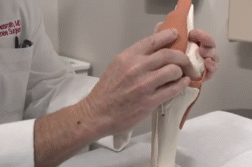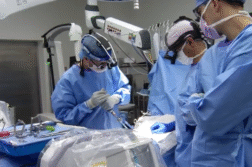VINELAND, N.J. (Ivanhoe Newswire)— It’s a common condition as we age. Degenerative disc disease refers to wear and tear on the ligaments in our back and neck, the discs that normally act as cushions between the bones in the spinal cord. Now, doctors are testing a new minimally invasive procedure for fusing discs and alleviating pain. FUSE Trial
Bob Fanucci is used to seeing the world from hundreds of feet in the air but after 30 years as an electrical lineman, the job took a toll.
“You know, you’re in a bucket or you’re on a pole. Climbing is a lot of looking up,” Fanucci described.
Eventually, Bob had symptoms he could no longer ignore.
“It just was keeping me up at night kind of pain. And I couldn’t look up, and I couldn’t turn, and the crunching noises,” Fanucci expressed.
X-rays of his neck showed damage to three discs of seven, putting pressure on the nerves.
Orthopedic spine and neck surgeon Rahul Shah, MD, felt Bob would benefit from surgery— entering the front of the neck to remove the damaged discs and replace them with an implant.
Bob was also part of the FUSE clinical trial.
Doctor Shah is testing a minimally invasive way of delivering a small titanium implant through a tiny tube in the back to stabilize the spine without making long incisions.
“The muscles bounce back quicker, better, and their function, we believe, is better,” explained Dr. Shah.
Bob started feeling the difference almost immediately.
“I got the full range of motion, I could drive, I could start physical therapy. It just astounded me that the results were that dramatic,” exclaimed Fanucci.
Doctor Shah says ideal candidates for the study are people with significant pain requiring surgery, and problems with three levels of neck vertebrae.
Contributors to this news report include: Cyndy McGrath, Executive Producer & Field Producer; Kirk Manson, Videographer; Roque Correa, Editor.
To receive a free weekly e-mail on Medical Breakthroughs from Ivanhoe, sign up at: http://www.ivanhoe.com/ftk
MEDICAL BREAKTHROUGHS
RESEARCH SUMMARY
TOPIC: FUSE TRIAL: BETTER BACKS FASTER?
REPORT: MB #4811
WHAT IS SPINAL FUSION: Spinal fusion surgery is performed to permanently connect two or more vertebrae in your spine, eliminating motion between them. It involves techniques designed to mimic the normal healing process of broken bones. During spinal fusion, your surgeon places bone, or a bonelike material within the space between two spinal vertebrae. Metal plates, screws and rods may be used to hold the vertebrae together, so they can heal into one solid unit. Spinal fusion permanently connects two or more vertebrae in your spine to improve stability, correct a deformity or reduce pain. It can also treat deformities of the spine like scoliosis, spinal weakness or instability, and a herniated disk. Generally, a spinal fusion procedure involves an incision to gain access to the vertebrae being fused, preparing the bone graft that fuses two vertebrae together, and the fusion to fuse the vertebrae together permanently.
(Source: https://www.mayoclinic.org/tests-procedures/spinal-fusion/about/pac-20384523)
SPINAL FUSION CANDIDATES: Spinal fusion is an option for people with radiating nerve pain from spinal stenosis. Patients with scoliosis and spondylolisthesis, a stress fracture that weakens bones so they are unable to maintain their proper position and shift are usually good candidates for a spinal fusion. If you do not have any of these conditions, smaller procedures such as a laminectomy, which is a spinal surgical procedure designed to help relieve compression within a vertebra, can be performed on an outpatient basis. Patients should only have a fusion if smaller procedures are not a good option. Some chronic back pain sufferers for whom other treatments have not worked are able to obtain relief through spinal fusion. Smokers are proven poor candidates for spinal fusion surgery because smoking impairs the body’s ability to heal properly. Also, patients who have arthritis throughout their lower back may not be good candidates due to the inability of their bones to fuse properly.
(Source: https://www.thespinehealthinstitute.com/news-room/health-blog/five-fast-facts-on-spinal-fusion)
NEW APPROACH TO SPINAL FUSION SURGERY: There is a new clinical study that is evaluating whether the Posterior Cervical Stabilization System improves fusion rates for cervical fusion patients when used as part of circumferential cervical fusion. The results so far indicate that patients who receive circumferential fusion with PCSS have a higher rate of fusion and fewer surgical failures. The Posterior Cervical Stabilization System is a small titanium implant that is surgically placed in the facet joints on the back side of the neck. PCSS, as part of the posterior cervical fusion is designed to be used with an ACDF to immobilize and stabilize the spine, which may improve fusion rates. Prior to placing the implants into the facet joints, the doctor will prepare the target joints with PMT surgical instruments and then deliver PCSS through a small tube to minimize muscle and tissue damage. The PMT surgical instruments are indicated for posterior cervical fusion in patients with degenerative disc disease. Dr. Rahul Shah, orthopedic spine and neck surgeon at Premier Orthopedic Spine Associates says, “We work with a metal straw and the cuts are about the size of a dime or less, so they heal almost looking like little pimples as compared to a bigger cut. So, there is less tissue scarring, less movement, and less retraction of the muscles. So, the muscles bounce back quicker, and their function is better”.
(Sources: https://rahulshahmd.com/fuse-clinical-study, Rahul Shah, MD)
FOR MORE INFORMATION ON THIS REPORT, PLEASE CONTACT:
TORI SICHTA
646-632-4571
If this story or any other Ivanhoe story has impacted your life or prompted you or someone you know to seek or change treatments, please let us know by contacting Marjorie Bekaert Thomas at mthomas@ivanhoe.com




